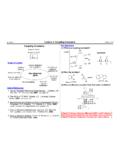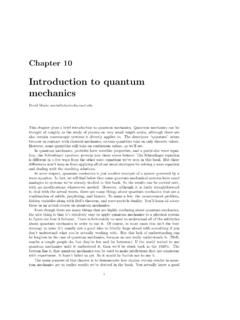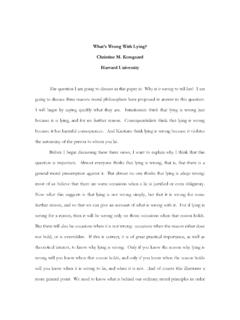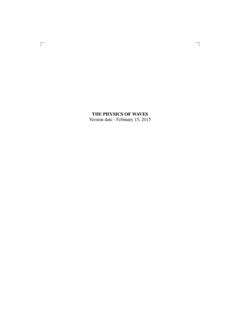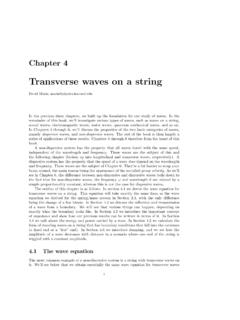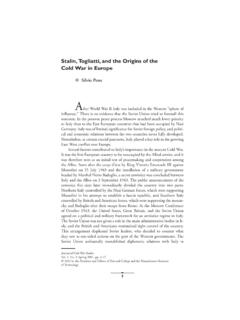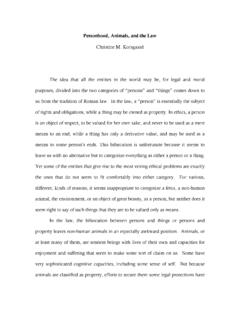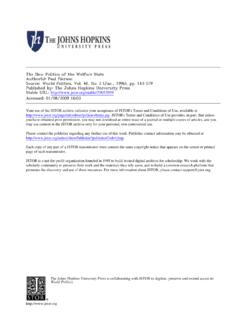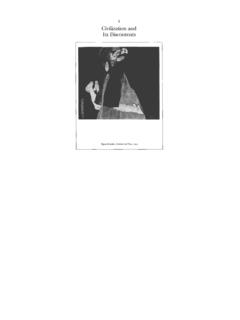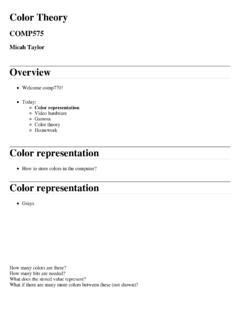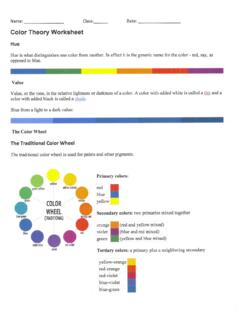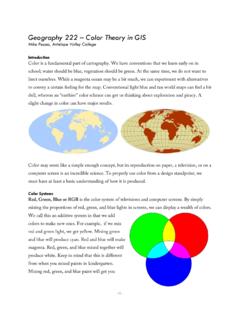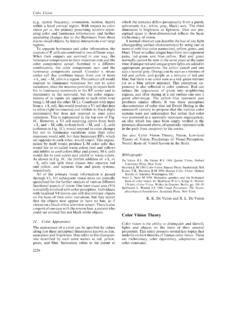Transcription of Queer of Color Theory - people.fas.harvard.edu
1 1 Queer of Color Theory Prof. Robin Bernstein African and African American Studies 183x Harvard University Tuesdays 1-3 pm, Fall 2012 Barker Center, room 316 Course website: Prof. Bernstein s Office: Boylston G31 email: <rbernst@fas> Office hours: Phone: Tuesdays 3-5pm Marlon Riggs (left) and Essex Hemphill (right), Tongues Untied (1989) In Aberrations in Black: Toward a Queer of Color Critique, Roderick A. Ferguson defines Queer of Color analysis as an interrogat[ion] of social formations as the intersections of race, gender, sexuality, and class, with particular interest in how those formations correspond with and diverge from nationalist ideals and practices. Queer of Color analysis is a heterogeneous enterprise made up of women of Color feminism, materialist analysis, poststructuralist Theory , and Queer critique.
2 (Ferguson, 149) Proceeding from this definition, our seminar investigates the theoretical work of Queer people of Color , primarily in the , from the 1970s to the present. We begin with Queer of Color Theory as a critical response to racism in (white) Queer Theory and to heterocentrism in ethnic studies and in communities of Color . We then move back in time to study Queer of Color Theory s roots in radical feminism in the 1970s and 80s and in AIDS and related experiences of loss during the 1980s and 90s. In the early twenty-first century, a critical mass of Queer of Color scholars began investigating the ways in which gender and sexuality figure in global economic and cultural structures. As David Eng, Judith Halberstam, and Jos Esteban Mu oz asked in their introduction to Social Text 84-85 (2005), What does Queer studies have to say about empire, globalization, neoliberalism, sovereignty, and terrorism?
3 What does Queer studies tell us about immigration, citizenship, prisons, welfare, mourning, and human rights? (Eng, Halberstam, and Mu oz , 2). These questions have defined Queer of Color Theory for the twenty-first century, and they frame the very recent scholarship that we read in the second half of our course cutting-edge books about nationalism, diasporic migration, everyday life, and revolution. 2 Assignments and requirements: Discussion leadership (varying dates) 20% Two meetings with professor (graded full credit/no credit) 5% Mid-semester Paper, due Monday, October 22, 3pm 10% Proposal for Final Project, due Monday, Nov. 12 (graded full credit/no credit) 5% Final Project, due Wednesday, December 12 35% Thoughtful, engaged, and respectful classroom participation 25% Discussion leadership: In this exercise, you will place our reading in direct conversation with a primary text.
4 Students will work in teams of two to bring into the classroom a primary text that relates in some complex way to one or more of the week s reading assignments. For example, the team might distribute a poem, manifesto, or work of visual art; play a song; or screen a brief film clip, YouTube video, television commercial, or music video. The team will contextualize the material for the class and will suggest ways in which the week s reading and the primary text might inform or challenge each other. The primary text should not merely exemplify some point in the reading, nor should the primary text be one that the assigned reading analyzes in depth. The reading, hearing, or viewing of the primary text and the initial contextualizing remarks should run between 10 and 15 minutes total.
5 Please do not exceed this limit. After the contextualizing comments and the reading, hearing, or viewing of the primary text, the team will facilitate the class s discussion of the text in relation to the week s reading. The team should expect to take primary responsibility for the seminar s first hour of discussion and secondary responsibility for the second hour. Mid-Semester Paper: Each student will write a 5-7 page paper that will accomplish EITHER of the following: a) critically engage with one or two assigned texts (for example, critique an argument, read one argument against or through another, etc.) OR b) use the ideas in one of our assigned reading to analyze a short primary text (for example, a poem, song, manifesto, sermon, legal decision, theatrical performance, interaction in everyday life, or work of visual art).
6 Each paper must have a clear thesis and must support that thesis with thoughtfully-chosen evidence from the text and/or performance. No outside research is necessary or desirable. With the professor s permission, a graduate student may complete this assignment by writing a publishable book review. Due MONDAY, October 22, 3pm, to Prof. Bernstein s mailbox in AAAS (Barker Center). Final Project: Each student will complete a substantial final project that engages deeply with the concepts in this course. An undergraduate student may write a 15-page paper or may propose an alternative form of engagement (the professor will work with students to craft viable alternative projects but ultimately reserves the right to decline any proposal). A graduate student s final project must consist of a 20-25 page scholarly paper.
7 Each student must submit a proposal for a final project regardless of form by 3pm on MONDAY, November 12, in Prof. Bernstein s mailbox in AAAS (Barker Center). General information: All books are on reserve at Lamont Library and for sale at the Harvard Coop. Late assignments will be docked one third of a letter grade for each day or partial day overdue. Please note that failure to complete any assignment can lower your final grade in excess of the stated percentage. If you need reasonable accommodations for a disability, please let Professor Bernstein know as soon as possible. 3 Professor Bernstein holds office hours from 2-3pm every Wednesday and 3-5pm every Tuesday (except when Harvard holds a faculty meeting, in which case Prof. Bernstein holds office hours from 3-4pm).
8 You are welcome to drop in, but students with appointments receive priority. You may reserve time online at If you have class during both sets of office hours, please email Professor Bernstein at <rbernst@fas> to make alternative arrangements. This course adheres to Harvard University policy on permitted collaboration, which reads as follows: Discussion and the exchange of ideas are essential to academic work. For assignments in this course, you are encouraged to consult with your classmates on the choice of paper topics and to share sources. You may find it useful to discuss your chosen topic with your peers, particularly if you are working on the same topic as a classmate. However, you should ensure that any written work you submit for evaluation is the result of your own research and writing and that it reflects your own approach to the topic.
9 You must also adhere to standard citation practices in this discipline and properly cite any books, articles, websites, lectures, etc. that have helped you with your work. If you received any help with your writing (feedback on drafts, etc), you must also acknowledge this assistance. SCHEDULE September 4. Introductions. Watch and discuss in class: Cheryl Dunye, dir., She Don t Fade (1991) Unit I: Queer of Color Critique September 11. Critiques of Theory , of queerness, of Queer Theory Barbara Christian, The Race for Theory , Cultural Critique 6 (Spring 1987): 51-63. Access online through JSTOR. Gloria Anzald a, To(o) Queer the Writer Loca, escritor y chicana, originally published 1991; in AnaLouise Keating, The Gloria Anzald a Reader, 163-175. Evelynn Hammonds, Black (W)holes and the Geometry of Black Female Sexuality, differences +3 (1994): 126-145.
10 Access online through EBSCO host. Cathy Cohen, Punks, Bulldaggers, and Queens: The Radical Potential of Queer Politics? GLQ: A Journal of Lesbian and Gay Studies vol. 3., no. 4 (1997): 437-465. Access online through GLBT Life with Full Text (EBSCO host). OPTIONAL: Sharon Marcus, Queer Theory for Everyone: A Review Essay, Signs vol. 31, no. 1 (August 2005): 191-218. Access online through JSTOR. September 18 The Queerness of Hip Hop/The Hip Hop of Queerness Readings TBD Guest speakers: C. Riley Snorton and Scott Poulson Bryant FRIDAY, September 21: The Queerness of Hip Hop/The Hip Hop of Queerness Symposium. See for detailed program. Register for free at 4 September 25. Re-Imagining Genealogies Audre Lorde, I Am Your Sister: Black Women Organizing across Sexualities, in Lorde, A Burst of Light: Essays (Ithaca, NY: Firebrand Books, 1988): 19-26.

